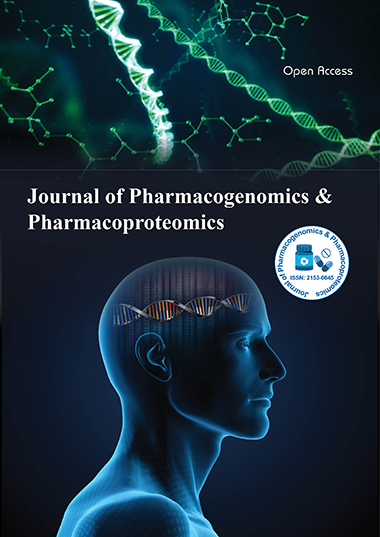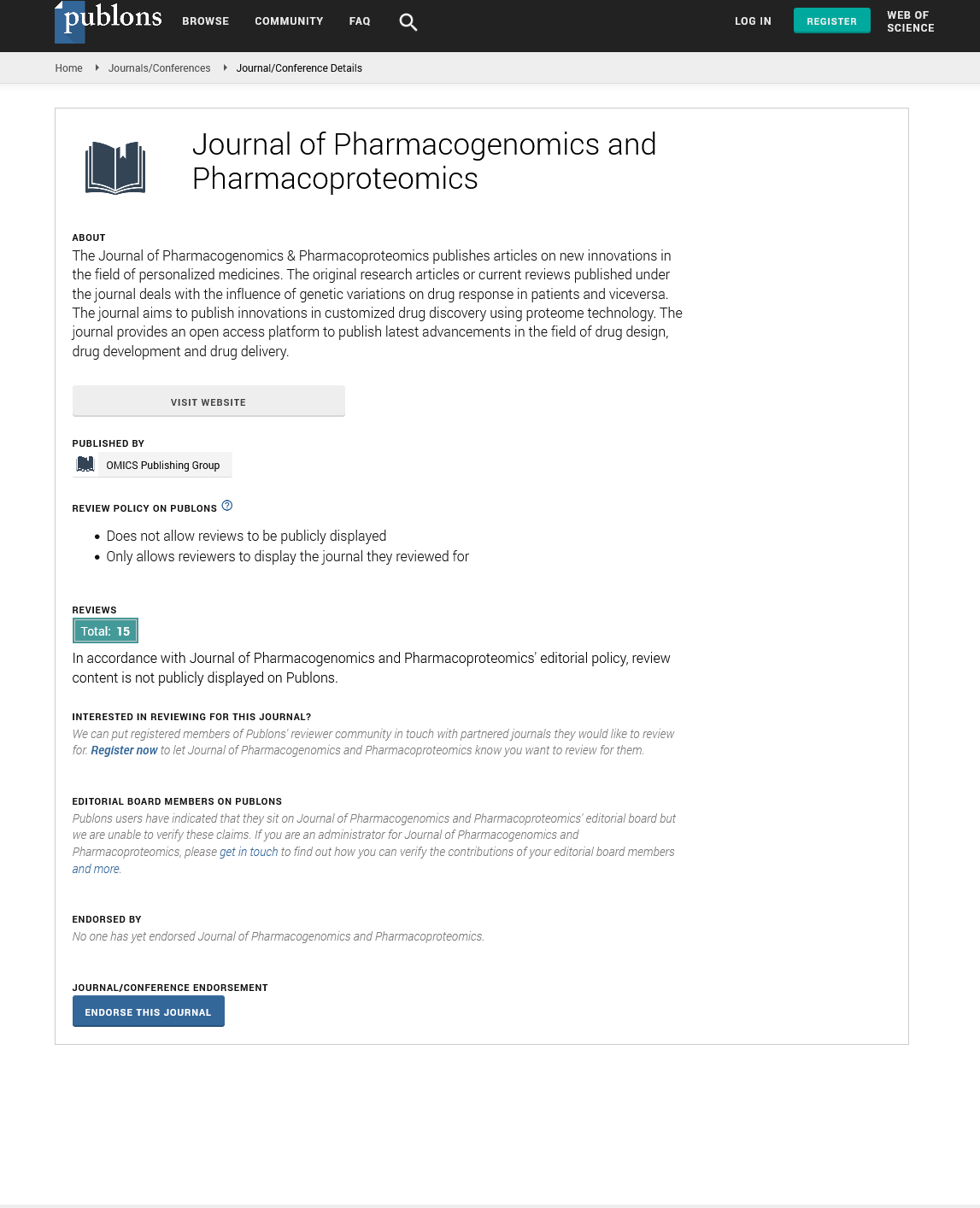Indexed In
- Open J Gate
- Genamics JournalSeek
- Academic Keys
- JournalTOCs
- ResearchBible
- Electronic Journals Library
- RefSeek
- Hamdard University
- EBSCO A-Z
- OCLC- WorldCat
- Proquest Summons
- SWB online catalog
- Virtual Library of Biology (vifabio)
- Publons
- MIAR
- Euro Pub
- Google Scholar
Useful Links
Share This Page
Journal Flyer

Open Access Journals
- Agri and Aquaculture
- Biochemistry
- Bioinformatics & Systems Biology
- Business & Management
- Chemistry
- Clinical Sciences
- Engineering
- Food & Nutrition
- General Science
- Genetics & Molecular Biology
- Immunology & Microbiology
- Medical Sciences
- Neuroscience & Psychology
- Nursing & Health Care
- Pharmaceutical Sciences
Perspective - (2024) Volume 15, Issue 1
Challenges in Proteomic Analysis for Assessing COVID-19 Lung Injury Severity
Zhang Xiao*Received: 01-Jan-2024, Manuscript No. JPP-24-24899; Editor assigned: 05-Jan-2024, Pre QC No. JPP-24-24899 (PQ); Reviewed: 19-Jan-2024, QC No. JPP-24-24899; Revised: 26-Jan-2024, Manuscript No. JPP-24-24899 (R); Published: 02-Feb-2024, DOI: 10.35248/2153-0645.23.15.084
Description
The severity of COVID-19 lung injury depends on numerous factors, including the individual’s health condition and environment. In order to gain a deeper understanding of the effects of this virus, proteomics analysis is an effective method in assessing the severity of lung injury. Proteomics is a technique used to study proteins in a sample, which are essential for various biological processes. Through proteomic analysis can identify and study proteins that are associated with particular diseases or conditions, like COVID-19 lung injury. With the help of this technology, we can understand how protein expression changes in response to different environmental cues and develop more effective treatments for those affected by this deadly virus. COVID-19 has been particularly devastating due to its ability to damage and inflame lungs. It has already had a significant impact on public health worldwide and it is important to understand more about its effects on respiratory systems. Proteomic analysis has provided valuable insights into this matter by analyzing the levels of various proteins in patients affected by COVID-19 lung injury. By studying these patterns, scientists have been able to better define which ones are associated with severe cases versus those who suffer from milder symptoms.
Proteome is defined as all the expressed proteins in an organism or cell at any given point in time. Proteomics is an analytical approach used to identify changes/differences between two states of a biological system using protein expression data, hence providing meaningful insights into underlying biology and disease mechanisms. The main objective is to reveal new information about protein expression across different conditions such as disease states or different treatments applied on samples for therapeutic purposes. It involves several steps like sample preparation, chromatography separation, Mass Spectrometry (MS) data acquisition and bioinformatics processing for downstream analysis and interpretation.
The pandemic is affecting us all in various ways and our understanding of the virus is still limited. As the virus, it is essential to analyze how COVID-19 affects different organs in the body. Proteomics, a branch of biochemistry that studies proteins, offers the potential to gain valuable insights into the severity of COVID-19 lung injury. Proteomics involves identifying and characterizing proteins and analyzing their interactions with each other. This information can be used to better understand how a disease affects specific organs in the body, such as the lungs. Through proteomics, can identify which proteins are involved in COPD (Chronic Obstructive Pulmonary Disease) and other lung diseases associated with COVID-19. By understanding which proteins are involved and how they interact, it can develop more effective treatments for COPD and other lung-related symptoms caused by COVID-19. In addition to analyzing protein changes associated with COPD, proteomics can also be used to study changes in proteins associated with other respiratory illnesses caused by COVID-19. By examining differences in protein expression between patients suffering from different respiratory illnesses due to COVID-19, it can gain insight into how these illnesses impact different organs. This information can then be used to develop targeted treatments for various respiratory illnesses related to COVID-19. Proteomics can also help determine which patients are more likely to suffer from severe lung injury due to COVID-19 infection. By analyzing changes in certain proteins over time, it can determine which patients have a greater risk of developing severe complications from their illness. This information could then be used to change treatments for those individuals who are at higher risk of developing severe lung injury due to COVID-19 infection. Proteomics provides a powerful tool for gaining insights into the severity of COVID-19 lung injury as well as potential treatments for COPD and other respiratory diseases caused by COVID-19 infection. Through proteomic analysis, researchers can identify key molecules involved in COPD and other respiratory illnesses associated with COVID-19 infection as well as determine which individuals may be at higher risk for severe Covid-related lung injury or complications.
Proteomics can play a critical role in understanding the severity of COVID-19 lung injury, as it is a powerful tool for classifying proteins associated with the disease. By analyzing the molecular composition of cells, proteomic analysis can provide insight into how the virus affects different individuals and groups and can allow for more precise diagnosis and management strategies based on individual needs. Researchers have identified at least 23 cell surface proteins that are present in higher concentrations in people with severe cases of COVID-19 than those with mild cases. Proteomic analysis has also revealed that some therapy targets vary significantly between patients, indicating that drug treatments may need to be changed specifically to each person's individual needs. The benefits of proteomic analysis for understanding the severity of COVID-19 lung injury cannot be understated as it has already helped identify important markers linked to successful treatment outcomes and improved diagnosis accuracy. Proteomics is a powerful technology used for analyzing the proteins present in a biological sample. It helps to identify new biomarkers, defining the severity of any disease and assesses the efficiency of treatments. In the current COVID-19 pandemic, proteomic analysis is being used to evaluate the severity of lung injury caused due to this virus. Despite its effectiveness, several challenges arise while using proteomics for understanding the impact of COVID-19 on lung damage.
Citation: Xiao Z (2024) Challenges in Proteomic Analysis for Assessing COVID-19 Lung Injury Severity. J Pharmacogenom Pharmacoproteomics. 15:084.
Copyright: © 2024 Xiao Z. This is an open-access article distributed under the terms of the Creative Commons Attribution License, which permits unrestricted use, distribution, and reproduction in any medium, provided the original author and source are credited.

